1955
The Finn enjoyed the official support from the IYRU
as the 1956 Olympic monotype and was already being
considered for the 1960 Olympics as well. Newcomers
to the Class interested in the construction of Finns
were referred by the IYRU to the Scandinavian Yachting
Union with limited success. Rickard Sarby gave valuable
personal advice, but was unable to help since he
had passed on all the rights for the design. Several
countries developed differing measurement instructions.
The IYRU regretted that no International Finn Association
had yet been formed to which it would have been
eager to grant international status.
|
|
|
Rinze
Koopmans, first President of the lFA 1956-1957
|
|
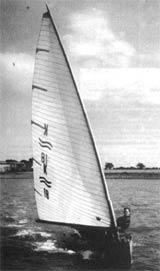 |
The
German speaking countries would have liked to see
the Finn fade away again in favour of the 1936
O-Jolle, and hoped secretly, that the Italians would
select that old type as the Olympic monotype for
1960. However the Italian Sailing Federation with
the present IYRU President Beppe Groce as the leading
force supported the Finn and even organised with
tremendous expenditure a big international Finn
event in Forte Dei Marmi with 31 participants from
10 nations.
The Commodore of the Royal Belgium Sailing Club
Henri Leten was the most active and powerful supporter
of the Finn outside of the Scandinavian countries.
He was well aware of the intention of the IYRU and
the discontent of many other nations with the administration
of the Finn by the Scandinavian Yachting Union.
On behalf of the Belgium Yachting Federation Henri
Leten invited all National Sailing Federations of
countries with active Finn sailors to attend a conference
in Brussels on November 12-13, 1955.
The agenda of that conference read:
1. Unification of the Finn rules.
2. Recognition of the Finn for the 1960 Olympic
Games.
3. Choice of the Finn for the 1960 Olympic Games.
Point 1 of that agenda would have been the responsibility
of the Scandinavian Yachting Union and points 2
and 3 of the International Yacht Racing Union. |
Richard
Murray,
IFA secretary 1957-1961, sailing at Itchenor in
1958 |
|
After the Scandinavian Yachting Union had not responded
to the politely phrased request of the IYRU to unify the
rules, to initiate an International Finn Association and
to apply for the international status of the Finn Class,
it questioned the legality of that conference in Brussels.
The four Scandinavian countries boycotted the endeavours
of Henri Leten, arguing that the organisation of such
a meeting would be their sole responsibility. But the
Scandinavian Yachting Union missed again the opportunity
to hand in the proper application to the IYRU in 1955.
Instead the IYRU itself decided at the 1955 November conference
to adopt the Finn as the one design for singlehanded sailing
as soon as the rules and plans were revised and given
a clean English text, and an International Finn Dinghy
Association could be founded. |
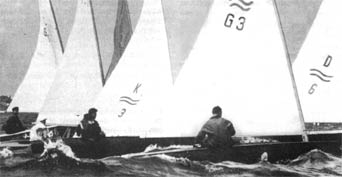 |
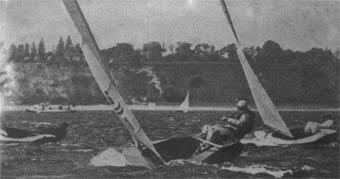 |
| Paul
Elvstrom, on far left, keeping his boat very flat
at Kiel |
|
Encouraging
for the Finn Class was the' donation of a Gold Cup by
F.G. Mitchell by the end of 1955, to be sailed for the
first time at Easter 1956 in Burnham-on-Crouch, England. |
1956
With the approval of the IYRU and under the protest of
the Scandinavian Yachting Union Henri Leten claimed by
January 1956 that the International Finn Association had
been founded in November 1955 in Brussels.
|
The
IYRU approved that the European Championship with
a crew of one (previously sailed in the 1936 O-Jolle)
be organised by Belgium for 1956 in the Finn Class.
Leten pushed to regard the newly created Finn Gold
Cup as the world championship of the Finn Class.
In addition, in early 1956 it was decided to select
the Finn as the monotype for the 1960 Olympics as
well. Many nations were preparing for the 1956 Olympics
at the end of the year in Melbourne. Even the Germans
took the old Finns out of storage (which had been
lying idle for 3 years) to sail the selections.
Dr. Soderhjelm from Finland and Henri Leten revised
the rules and J. Loeff from the Netherlands redrew
the plans of the Finn. The Gold Cup in Burnham on
Crouch turned out as a big success with 46 boats
from 12 nations participating. Under these circumstances
it was easy for Henri Leten to organise the first
Annual General Meeting of the International Finn
Association at the occasion of the European Championship
on August 23, 1956. Disregarding the pending question,
whether the meeting in Brussels in November 1955
was legal or not, the results of this conference
were accepted, and the legal foundation of the International
Finn Association was acknowledged. The Scandinavian
Yachting Union had given up its opposition and transferred
all the rights of administration and on the plans
to the IFA. L.R. Koopmans from Holland was elected
as the first president and Henri Leten as secretary
of the IFA. A Technical Committee with Rickard Sarby
as chairman and Richard Murray (UK) and B. Dotsch
(Belgium) as members was created for interpretation
and advice on the rules. |
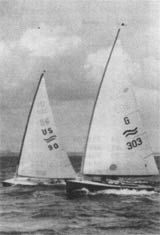 |
Fred
Miller and
Willy Kuhweide at the
Finn Gold Cup in 1961 |
|
The founding members of the IFA were the national
Finn Associations of England, Holland, Belgium,
South Africa, Finland as the only Scandinavian country,
Argentina, France and Spain. Germany, Switzerland,
Sweden, Turkey, Portugal, Norway, Ireland, and Poland
had sent representatives to that first AGM in 1956.
Since Paul Elvstrom considered the sailing conditions
of the Loosdrecht lakes unacceptable for a European
Championship, Denmark was not represented.
M. Skaugen (Norway) proposed Rules for the IFA,
which are the first draft of a constitution. They
include the suggestion to publish a Finn Bulletin
to be sent to members free of charge (later to become
FINNFARE).
In the fall of 1956 a national Finn association
was founded in the Federal Republic of Germany with
Curd Ochwadt as the driving force. In November 1956
the IYRU granted international status (category
1) to the Finn Class.
|
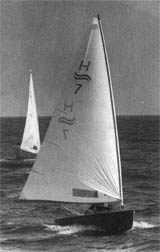 |
1957
Already in its second year the Gold Cup was generally
accepted as the official World Championship of the
Finn Class. In 1957 it was organised in Sweden on
the huge inland Vanersee by the later third president
of the IFA Bengt Hornevall. 70 boats from 13 nations
participated which was a record by any standard
for that time. The 1957 AGM was also organised at
the occasion of the Gold Cup for the first time.
Henri Leten was elevated from Secretary to President
and Richard Murray from the UK became the new secretary
because English was the official language of the
IFA.
The national Finn associations of Portugal, Federal
Republic of Germany, Norway, New Zealand, Sweden,
United States, Poland and Denmark joined the IFA
in 1957. As early as the 1957 AGM the countries
which were to organise the Gold Cups up to 1967
were determined. Surprisingly that schedule was
actually adhered to in the following 10 years. Dacron
sails and fibreglass boats were considered but not
yet accepted at the 1957 AGM.
|
|
Since
the Kiel Week of 1957 was a great success for the Finn
Dinghy the new Class bypassed the traditional O-Jolle
in the German speaking countries after that date. Paul
Elvstrom remained the leading force in the technical development
of the Finn. He constantly improved the bendy mast, longitudinally
stiff boom and corresponding sail. After 1957 the so called
'Elvstrom bailers' became popular, which several people
claim to have invented, including Elvstrom and Sarby. |
1958
A number of new national Finn associations joined
the IFA. Richard Murray collected the subscriptions
and achieved such a good surplus, that he suggested
that the fees should be reduced.
In local races in the US dacron sails were used
on an experimental basis and proved to be superior,
especially after a rain or a capsize. So the IYRU
approved to allow the sail to be made of woven cloth
|
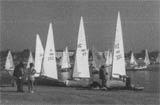 |
of even thickness as from 1st Jan 1960. Pressure
to built Finns from GRP increased. In Switzerland
Airex built some experimental boats. The IYRU agreed
to the new material in principle. The Finn Class
had to face the first technical revolution. For
the years to come the challenge was to remain the
leading single handed boat without outdating the
existing hulls. Rickard Sarby built an FD and partly
lost interest in the Finn Class. |
|
|